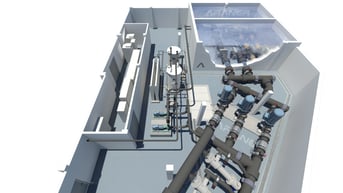Seawater has always been used as a practical resource for humankind in a wide extent. From the industries of fishing to medicine, it has then passed unavoidably through the energy field; electricity production or heat rejection are common practices in coastal industries. The latter mentioned application presents several perks over other heat rejection methods, which makes it a technology that should be taken into account for any future project. The tendency in the new real-estate developments is the use of District Cooling and District Heating systems, due to the big advantages that they present. When placing a DC plant in a residential complex, designers try to disguise it with a basement location or with embellished facades matching the local architecture. This is just one of the reasons why Seawater District Cooling Network systems are a consolidated solution.

Why Seawater Condensation for District Cooling? 6 Main Advantages
1. Zero fresh water consumption
The water used in a Seawater District Cooling system is taken directly from the sea, as it drives the heat away from the DC plant condenser. This one-pass-through method means that all the water taken from the sea is released back, with no water losses. No additional fresh water is required.
2. Building integration flexibility
The District Cooling plant can be completely hidden inside a building, which makes the system more visually appealing. This can have a positive impact on the skyline of the city both visually and acoustically, and is an important feature for the big luxury real-estate developments where aesthetics and comfort are of the utmost importance.
3. Good and more stable efficiencies
The DC plant efficiency depends on the condensation temperature. Seawater temperature has more often a lower temperature than the ambient temperature, enhancing the efficiency of the plant. Moreover, the sea water is subjected to less temperature variations as it is a big water mass, resulting in more steady efficiencies.
4. No rooftop usage
As the heat is driven away by the seawater, it is not necessary for the installation of heat exchangers for the rejection into the ambient air, such as air-cooled condensers or cooling towers. This enables the use of the rooftop for other purposes, as it is often a valuable space for recreational uses, plus it facilitates the use of surrounding spaces (no noises, no visual blocking, no warm air pollution).
 Figure 1: Interior of ARANER’s AYLA project
Figure 1: Interior of ARANER’s AYLA project
5. No chemical storage
Seawater should be treated in order to avoid the proliferation of marine life in the system. For this purpose, the own salt that is contained in the water can be used by means of an electro-chlorination system. Part of the seawater is conver ted into an anti-biofouling, avoiding the consumption of other components to be added to the sea water. Find the results downloading Ayla Oasis Resort District Cooling case study.
6. Sustainable technology
There is no contact between seawater and other fluids (such as refrigerants and oils) during the process, so water can be released back into the sea with no change but a slight increase of temperature. Seawater is abundant – it covers up to 70% of the Earth’s surface. On the other hand, fresh water is a scarce resource that represents 3.5% of the total water in the planet, from which 70% is frozen in the poles.
 Figure 2: Example of a District Cooling Network solution for cities
Figure 2: Example of a District Cooling Network solution for cities
Importance of a Tailor-Made Solution
The particular conditions of the project are essential in the development of a seawater condensation solution. The intake and outfall points are carefully studied in order to avoid the malfunction of the plant and to fulfill all environmental regulations. For each particular project there should be the elaboration of environmental impact studies, geological reports, water quality studies, bathymetric charts elaborations, seawater tides and currents studies, and more. ARANER has the capabilities for performing projects within the industry standards and up to client satisfaction, complying with every local and international regulation. Each project is different, and that is why ARANER and their expert team analyze each individual project to determine the optimum condensation technology.
Conclusion: A Step Into Smart Cities Integration
Seawater heat rejection is the optimal solution for new big coastal developments where sufficient seawater flow rate is technically and economically feasible. As the world keeps growing, the sustainable management of the available resources and their optimization play a key role in the development of the cities. All utility services (heat, cold, electricity, water, gas, sewage, and communications) should be harmonized and coordinated for the comfort of residents and visitors. ARANER offers extensive experience for integrating Seawater District Cooling technologies into your next project.









